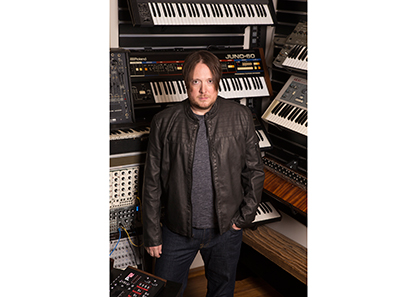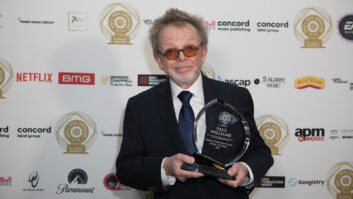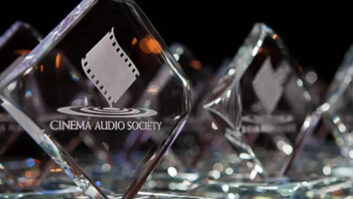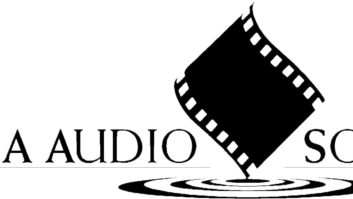
Inside a garage tucked behind a tall hedge just off a main thoroughfare in the San Fernando Valley in Los Angeles, some of the most impactful television music in recent years is created. This is composer Dave Porter’s lair, where he came up with the innovative and evocative score for Breaking Bad. Now he’s doing it again on that show’s spin-off/prequel, Better Call Saul.
For Better Call Saul, Porter is working with the same team as Breaking Bad, from creators to writers to music editors to music supervisor, Thomas Golubic. The challenge, musically, is to not fall into Breaking Bad habits, but to reinvent themselves while achieving the same effect. Creators Vince Gilligan and Peter Gould described Saul to Porter as “a small hero”—the very opposite of Breaking Bad’s lead character, Walter White.
The working process is the same as before. Porter chooses not to read the script. He watches a fully edited episode the day before he meets with the creative team for a spotting session. He watches once for the pure visceral reaction, then again with stops and starts and note-taking.
“The writing is so clever, I’m afraid that if I knew what was going to happen, I might unintentionally lead people with the music,” Porter says. “If I watch it cold, then I have a sense of remembering how surprised I was at a twist. I don’t want to tip the audience. I want to make it as big a surprise or twist as I can.”
At the spotting session—which can last up to five hours—the scenes are broken down one at a time with many discussions about effects, such as footsteps and dog barks. Porter starts the score talk with questions rather than offering his thoughts. This way he can ensure he has the same vision and catches all the nuances. For Better Call Saul, getting into a rhythm ended up being a long process for all involved, and one of the more difficult endeavors of Porter’s composing career, he says. Where Porter was scoring episodes of Breaking Bad at a rate of one a week, the first few episodes of Saul took up to three weeks each.
The big difference for Porter from Breaking Bad is the lack of synthesizer sounds on Better Call Saul. There is a scene in the desert in episode two, “Mijo,” where Saul is on his knees—a familiar setting from Breaking Bad—that proved to be a pivotal moment for Porter as a composer. “It was the comparison point for me between the two shows,” he explains. “Even as I was working on the pilot, I jumped ahead to work on that scene. I knew if I could figure out how to do that scene that was so similar and make it sound different, but achieve the same things musically, then I’d have a key to how to approach the show as a whole. The score for that scene is less big, but I hope it still has the same ability to push tension and raise the stakes.”
For Better Call Saul, and the titular character in particular, Porter—who works wholly in Pro Tools HD 10—envisions a repurposing of classic rock instruments: bass guitar, Rhodes, Wurlitzer, Mellotron, organs and electric pianos, pieces that have an aged quality to them. This becomes more retro when scoring scenes for Chuck, Saul’s older brother. Using baritone guitar, old tremolo sounds, twangy but low and deep, Porter sets the tone for the authoritarian figure. For the desert scene, there is a combination of played and sampled live instruments, among them an overblown flute, hammer dulcimer, harp, bass guitar played up high so it sounds percussive, and organs. The result has a Middle Eastern vibe that uncannily lends itself to the inherently Western motif of Better Call Saul, which shares its Albuquerque, N.M., locale with Breaking Bad.
“Whether it was synthesized originally or not, on Breaking Bad, sounds were a lot more processed. On Better Call Saul, there’s much less of that,” Porter says. Speaking of a specific scene where Saul is feverishly unwinding the paper towels from their roll, Porter says, “There are found sounds in the percussion: plastic bottles, ethnic drums, shakers, a wine bottle. On Breaking Bad, it might have been run through a guitar amp. Here, it is presented much more as is, much more clean, more spare, smaller. Here, it’s much more organic, earthy. There isn’t the science element that was so present in Breaking Bad.”

There is a frenetic courthouse montage of Saul making deals with various lawyers, conferencing with clients, and dealing with the court staff. A piece from Vivaldi is used, but redone for the show so that it was more relatable and more connected to Porter’s score. For this, Porter did a lot of preparatory work for the musicians.
“My hands were a little tied because they had cut the picture to a recording they already had,” he says. “I had to map that very carefully tempo-wise. These are live humans, not computers playing perfectly. It took a long time to match that performance so I could build a click track and a template in Pro Tools, so that when we record it, our players could follow and it would be exactly the same. They don’t like it all the time, but when you write to picture, it is so important to be exactly where you need to be.”
Formally trained, Porter’s understanding of tempo starts with a metronome, with which he watches a scene until he finds a tempo that either fits with the picture or with the music he has in mind. Says Porter, “Great picture editors are often very musical people. I find they often cut on a very specific tempo. Once you find that tempo, or series of tempos if it changes in a scene, it gives you a great floor plan to build your piece of music around.”
This ties in with the dialog and writing as well. “Great actors have a cadence that good writing has, too,” Porter says. “You find an inherent pace that can guide you musically that you don’t want to be fighting. You’re trying to work with it. From a purely composer standpoint, your moments to say something musically are the moments in between.”
Porter’s involvement goes far past what you would expect. No detail left unattended, he scored the dramatic telenovela that Tuco’s grandmother is watching. He designed the unique cell phone rings you hear. And keep a sharp ear for when the elevator chimes at the law offices of Hamlin, Hamlin, & McGill. Porter created that sound, too.






